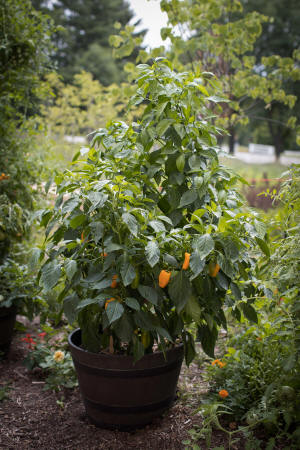|
 Grow
an Abundant Harvest of Peppers This Season Grow
an Abundant Harvest of Peppers This Season
By Melinda Myers
[March 22, 2025]
Whether you garden on an acre or a balcony, there’s
always room for peppers. Grow them in a vegetable garden, container,
or with your flowers. The colorful fruit of many varieties makes
them a decorative addition to any garden.
For those that like it hot, get to know the Scoville scale. This
system rates the relative hotness of peppers with bell peppers
rating 0, jalapeno at 2,500 to 5,000, cayenne rated 30,000 to
50,000, and habanero receiving the superhot 100,000 to 300,000
Scoville Heat Units (SHU). This scale can help you determine which
hot pepper is best for you. For those who like really hot peppers,
the Ghost pepper averages about 1 million SHU, Carolina Reaper
averages 1.6 million SHU and Pepper X measures 2.7 million SHU. |
|
Whether you grow sweet or hot peppers, proper care
from planting to harvest will yield the best flavor and an abundant
harvest. Grow peppers in a sunny location with moist, well-drained
soil. Add several inches of organic matter into the top 8 to 12” of
soil, if gardening in poorly drained clay soil or fast draining
sandy or rocky soils. This compost improves drainage and increases
the water holding ability of fast draining soils. This is also a
good time to add a low nitrogen, slow-release fertilizer.
Peppers, like its cousins, tomatoes and eggplants, like it warm.
Wait for the soil to warm to 60° degrees, about two weeks after the
last spring frost. Colder temperatures in the 40’s can stunt and
damage your transplants.
You can jump start the season with the help of cloches,
wall-o-waters, and floating row covers. These protect your plants
from frost and cooler temperatures, which are often common at the
start of the season. Use them to keep plants warm and help shorten
the time to harvest.
Plant peppers 18 to 20 inches apart depending on the variety. Check
the tag for mature size and recommended spacing. Make the most of
your available space by planting in wide rows. Stagger rows within
the bed, allowing just enough room for plants to reach their full
size. Design pathways to allow for easy access to all the plants
within the wide row.
Grow a few peppers in containers alone or mix them with herbs and
flowers. A 2-to-3-gallon pot is perfect for a pepper plant and its
smaller companions. Check the soil moisture daily and water
thoroughly when the top inch of soil is dry.
Make sure pepper plants growing in the ground receive about an inch
of water each week. Supplement rainfall as needed, applying water to
the soil surface using a watering wand, soaker hose or drip
irrigation. Spread a layer of shredded leaves, evergreen needles or
other organic material over the soil surface to conserve moisture,
keep roots cool as temperatures soar, and help suppress weeds.
Once the fruit forms, you may need to add fertilizer. Let the
plants’ growth and fertilizer directions be your guide.
[to top of second column] |

Peppers grow and produce best when day temperatures
are 70 to 80 degrees and night temperatures are 60 to 70 degrees.
Hot peppers seem to tolerate the heat better than sweet varieties.
Cold, heat, and drought are the most common causes of blossom drop,
misshapen fruit, and a poor harvest. Night temperatures over 90
degrees and under 55 degrees can cause blossoms to drop. Continue
providing proper care and wait for better weather for flowering and
fruiting.
With proper care throughout the season and a bit of cooperation from
the weather, you are sure to enjoy an abundant harvest.
Melinda Myers has written more than 20 gardening books,
including the Midwest Gardener’s Handbook, 2nd Edition and Small
Space Gardening. She hosts The Great Courses “How to Grow Anything”
instant video and DVD series and the nationally syndicated Melinda’s
Garden Moment TV & radio program. Myers is a columnist and
contributing editor for Birds & Blooms magazine and was commissioned
by Summit for her expertise to write this article. Myers’ website is www.MelindaMyers.com.
[Photo courtesy of MelindaMyers.com]

|